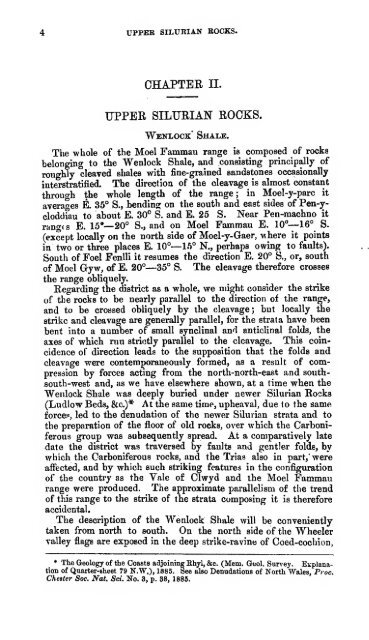The geology of the neighbourhoods of Flint, Mold, and Ruthin ...
The geology of the neighbourhoods of Flint, Mold, and Ruthin ...
The geology of the neighbourhoods of Flint, Mold, and Ruthin ...
Create successful ePaper yourself
Turn your PDF publications into a flip-book with our unique Google optimized e-Paper software.
UPPER SILUHIAN BOCKS.<br />
CHAPTER II.<br />
UPPER SILURIAN ROOKS.<br />
Wenlock" Shale.<br />
<strong>The</strong> whole <strong>of</strong> <strong>the</strong> Moel Fammau raDge is composed <strong>of</strong> rocks<br />
belonging to <strong>the</strong> Wenlock Shale, <strong>and</strong> consisting principally <strong>of</strong><br />
roughly cleaved shales with fine-grained s<strong>and</strong>stones occasionally<br />
interstratified. <strong>The</strong> direction <strong>of</strong> <strong>the</strong> cleavage is almost constant<br />
through <strong>the</strong> whole length <strong>of</strong> <strong>the</strong> range; in Moel-y-parc it<br />
averages E. 35° S., bending on <strong>the</strong> south <strong>and</strong> east sides <strong>of</strong> Pen-ycloddfau<br />
to about E. 30° S. <strong>and</strong> E. 25 S. Near Pen-machno it<br />
ranges E; 15'— 20° S., <strong>and</strong> on Moel Fammau E. 10°—16° S.<br />
(except locally on <strong>the</strong> north side <strong>of</strong> Moel-y-Gaer, where it points<br />
in two or three places E. 10°— 16° N., perhaps owing to faults).<br />
South <strong>of</strong> Foel Fenlli it resumes <strong>the</strong> direction E. 20° S., or, south<br />
<strong>of</strong> Moel Gyw, <strong>of</strong> E. 20°—35° S. <strong>The</strong> cleavage <strong>the</strong>refore crosses<br />
<strong>the</strong> range obliquely.<br />
Eegarding <strong>the</strong> district as a whole, we might consider <strong>the</strong> strike<br />
<strong>of</strong> <strong>the</strong> rocks to be nearly parallel to <strong>the</strong> direction <strong>of</strong> <strong>the</strong> range,<br />
<strong>and</strong> to be crossed obliquely by <strong>the</strong> cleavage; but locally <strong>the</strong><br />
strike <strong>and</strong> cleavage are generally parallel, for <strong>the</strong> strata have been<br />
bent into a number <strong>of</strong> small synclinal <strong>and</strong> anticlinal folds, <strong>the</strong><br />
axes <strong>of</strong> which run strictly parallel to <strong>the</strong> cleavage, This coincidence<br />
<strong>of</strong> direction leads to <strong>the</strong> supposition that <strong>the</strong> folds <strong>and</strong><br />
cleavage were contemporaneously formed, as a result <strong>of</strong> compression<br />
by forces acting from <strong>the</strong> north-north-east, <strong>and</strong> southsouth-west<br />
<strong>and</strong>, as we have elsewhere shown, at a time when <strong>the</strong><br />
Wenlock Shale was deeply buried under newer Silurian Rocks<br />
(Ludlow Beds, &c.)* At <strong>the</strong> same time, upheaval, due to <strong>the</strong> same<br />
force?, led to <strong>the</strong> denudation <strong>of</strong> <strong>the</strong> newer Silurian strata <strong>and</strong> to<br />
<strong>the</strong> preparation <strong>of</strong> <strong>the</strong> floor <strong>of</strong> old rocks, over which <strong>the</strong> Carboni-<br />
ferous group was subsequently spread. At a comparatively late<br />
date <strong>the</strong> district was traversed by faults <strong>and</strong> gentler folds, by<br />
which <strong>the</strong> Carboniferous rocks, <strong>and</strong> <strong>the</strong> Trias also in part,' were<br />
affected, <strong>and</strong> by which such striking features in <strong>the</strong> configuration<br />
<strong>of</strong> <strong>the</strong> country as <strong>the</strong> Vale <strong>of</strong> Clwyd <strong>and</strong> <strong>the</strong> Moel Fammau<br />
range were produced. <strong>The</strong> approximate parallelism <strong>of</strong> <strong>the</strong> trend<br />
<strong>of</strong> this range to <strong>the</strong><br />
accidental.<br />
strike <strong>of</strong> <strong>the</strong> strata composing it is <strong>the</strong>refore<br />
<strong>The</strong> description <strong>of</strong> <strong>the</strong> Wenlock Shale will be conveniently<br />
taken from north to south. On <strong>the</strong> north side <strong>of</strong> <strong>the</strong> Wheeler<br />
valley flags are exposed in <strong>the</strong> deep strike-ravine <strong>of</strong> Coed-cochion,<br />
* <strong>The</strong> Geology <strong>of</strong> <strong>the</strong> Coasts adjoining Rhyl, &c. (Mem. Geol. Survey. Explanation<br />
<strong>of</strong> Quarter-sheet 79 N.W.), 1885. See also Denudations <strong>of</strong> North Wales, Proc.<br />
Chester Soc. Nat. Set. No. 3, p. 38, 188S.



